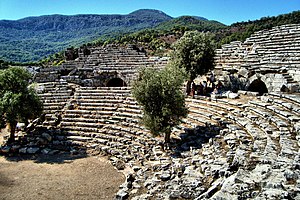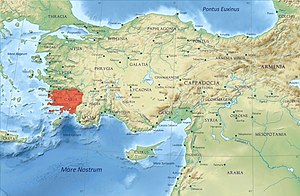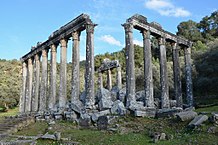Caria
| Caria (Καρία) | |
|---|---|
| Ancient region of Anatolia | |
 Theater inKaunos | |
| Location | SouthwesternAnatolia,Turkey |
| State existed | 11th–6th century BC |
| Language | Carian |
| Biggest city | Halicarnassus (modern-dayBodrum,Muğla,Turkey) |
| Roman province | Asia |
 | |
Caria(/ˈkɛəriə/;fromGreek:Καρία,Karia;Turkish:Karya) was a region of westernAnatoliaextending along the coast from mid-Ionia(Mycale) south toLyciaand east toPhrygia.[1]TheCarianswere described byHerodotusas being Anatolian mainlanders and they called themselves Caria because of the name of their king.[2]He reports the Carians themselves maintained that they were Anatolian mainlanders intensely engaged inseafaringand were akin to theMysiansand theLydians.[2]The Carians spokeCarian,a nativeAnatolian languageclosely related toLuwian.Also closely associated with the Carians were theLeleges,which could be an earlier name for Carians.
Municipalities of Caria[edit]


Cramer's detailed catalog of Carian towns is based entirely on ancient sources.[3]The multiple names of towns and geomorphic features, such as bays and headlands, reveal an ethnic layering consistent with the known colonization.
Coastal Caria[edit]
Coastal Caria begins withDidymasouth ofMiletus,[4]but Miletus had been placed in the pre-Ion Caria. South of it is the Iassicus Sinus (GüllükKörfezi) and the towns ofIassusandBargylia,giving an alternative name of Bargyleticus Sinus to Güllük Körfezi, and nearby Cindye, which the Carians calledAndanus.After Bargylia isCaryandaor Caryinda, and then on theBodrumPeninsulaMyndus(Mentecha or Muntecha), 56 miles (90 km) from Miletus. In the vicinity is Naziandus, exact location unknown.
On the tip of the Bodrum Peninsula (Cape Termerium) is Termera (Telmera, Termerea), and on the other side Ceramicus Sinus (Gökova Körfezi). It "was formerly crowded with numerous towns."[5]Halicarnassus,a Dorian Greek city, was planted there among six Carian towns:Theangela,Sibde,Medmasa,Euranium,Pedasaor Pedasum, andTelmissus.These with Myndus and Synagela (or Syagela or Souagela) constitute the eight Lelege towns. Also on the north coast of the Ceramicus Sinus isCeramusand Bargasus.
On the south of the Ceramicus Sinus is the Carian Chersonnese, or Triopium Promontory (Cape Krio), also called Doris after theDoriancolony ofCnidus.At the base of the peninsula (Datça Peninsula) is Bybassus or Bybastus from which an earlier names, the Bybassia Chersonnese, had been derived. It was now Acanthus and Doulopolis ( "slave city" ).
South of the Carian Chersonnese is Doridis Sinus, the "Gulf of Doris" (Gulf ofSymi), the locale of the Dorian Confederacy. There are three bays in it: Bubassius,Thymniasand Schoenus, the last enclosing the town of Hyda. In the gulf somewhere are Euthene or Eutane, Pitaeum, and an island:Elaeusor Elaeussa nearLoryma.On the south shore is the Cynossema, or Onugnathos Promontory, oppositeSymi.
South of there is theRhodian Peraea,a section of the coast underRhodes.It includesLorymaor Larymna in Oedimus Bay, Gelos, Tisanusa, the headland of Paridion, Panydon or Pandion (Cape Marmorice) with Physicus,Amos,Physca or Physcus, also called Cressa (Marmaris). Beyond Cressa is the Calbis River (DalyanRiver). On the other side isCaunus(near Dalyan), withPisilisor Pilisis andPyrnosbetween.
Then follow some cities that some assign to Lycia and some to Caria:Calyndaon the Indus River,Cryaand Alina in the Gulf of Glaucus (Katranci Bay or the Gulf ofMakri), the Glaucus River being the border. Other Carian towns in the gulf are Clydae or Lydae and Aenus.
Inland Caria[edit]


At the base of the east end ofLatmusnearEuromus,and near Milas where the current villageSelimiyeis, was the district of Euromus or Eurome, possibly Europus, formerly Idrieus and Chrysaoris (Stratonicea). The name Chrysaoris once applied to all of Caria;[citation needed]moreover, Euromus was originally settled fromLycia.Its towns are Tauropolis,Plarasaand Chrysaoris. These were all incorporated later intoMylasa.Connected to the latter by a sacred way areLabraundaandSinuri.Around Stratonicea is alsoLaginaas well asPanamara,TendebaandAstragon.
Further inland towardsAydınisAlabanda,noted for itsmarbleand itsscorpions,Orthosia,Cosciniaor Coscinus on the upperMaeanderandAlinda.To the east is the religious centreHyllarima.At theconfluenceof the Maeander and the Harpasus isHarpasa(Arpaz). At the confluence of the Maeander and the Orsinus, Corsymus or Corsynus isAntioch on the Maeanderand on the Orsinus in the mountains a border town withPhrygia,Gordiutichos ( "Gordius' Fort" ) nearGeyre.Founded by theLelegesand called Ninoe it became Megalopolis ( "Big City" ) andAphrodisias,sometime capital of Caria.[citation needed]
Other towns on the Orsinus are Timeles and Plarasa.Tabaewas at various times attributed to Phrygia, Lydia and Caria and seems to have been occupied by mixed nationals. Caria also comprises the headwaters of the Indus and Eriya or Eriyus and Thabusion on the border with the small state ofCibyra.
History[edit]


Bronze Age[edit]
Caria is often identified with the Bronze Age region ofKarkiya(orKarkisa) known from Hittite texts, though this identification is uncertain.[6][7][8]
Greek settlement[edit]

Caria was settled by Greek immigrants in theEarly Iron Age[citation needed].Their presence is attested byprotogeometric pottery[citation needed]which appears in the area around 1100 BC, along with other markers of Greek material culture.[9]
The coast of Caria was part of theDoric hexapolis( "six-cities" ).[citation needed]
An account also cited thatAristotleclaimed Caria, as a naval empire, occupiedEpidaurusand Hermione and that this was confirmed when the Athenians discovered the graves of the dead fromDelos.[10]Half of it were identified as Carians based on the characteristics of the weapons they were buried with.[10]
Lydian province[edit]
The expansionism ofLydiaunderCroesus(560-546 BC) incorporated Caria briefly into Lydia before it fell before the Achaemenid advance.
Persian satrapy[edit]

Caria was then incorporated into the PersianAchaemenid Empireas asatrapy(province) in 545 BC. The most important town wasHalicarnassus,from where its sovereigns, the tyrants of theLygdamid dynasty(c.520-450 BC), reigned. Other major towns wereLatmus, refounded as Heracleia under Latmus,Antiochia,Myndus,Laodicea,AlindaandAlabanda.Caria participated in theIonian Revolt(499–493 BC) against the Persian rule.[11]



During theSecond Persian invasion of Greece(480-479 BC), the cities of Caria were allies ofXerxes Iand they fought at theBattle of Artemisiumand theBattle of Salamis,where the Queen ofHalicarnassusArtemisiacommanded the contingent of 70 Carian ships.Themistocles,before the battles of Artemisium and Salamis, tried to split the Ionians and Carians from the Persian coalition. He told them to come and be on his side or not to participate at the battles, but if they were bound down by too strong a compulsion to be able to make revolt, when the battles begin, to be purposely slack.[13]Plutarch in his work, The Parallel Lives, at The Life of Themistocles wrote that: "Phanias (Greek:Φαινίας), writes that the mother of Themistocles was not aThracian,but a Carian woman and her name was Euterpe (Eυτέρπη), and Neanthes (Νεάνθης) adds that she was from Halicarnassus in Caria. ".[14]
After the unsuccessful Persian invasion of Greece in 479 BC, the cities of Caria became members of the Athenian-ledDelian League,but then returned to Achaemenid rule for about one century, from around 428 BC. Under Achaemenid rule, the Carian dynastMausolustook control of neighbouringLycia,a territory which was still held byPixodarusas shown by theXanthos trilingual inscription.
The Carians were incorporated into theMacedonian Empirefollowing the conquests ofAlexander the Greatand theSiege of Halicarnassusin 334 BC.[15]
Halicarnassus was the location of the famedMausoleumdedicated toMausolus,asatrapof Caria between 377–353 BC, by his wife,Artemisia II of Caria.The monument became one of theSeven Wonders of the Ancient World,and from which the Romans named any grand tomb amausoleum.
Macedonian empire[edit]
Caria was conquered byAlexander IIIof Macedonin 334 BC with the help of the former queen of the landAda of Cariawho had been dethroned by thePersian Empireand actively helped Alexander in his conquest of Caria on condition of being reinstated as queen. After their capture of Caria, she declared Alexander as her heir.[15]
Roman-Byzantine province[edit]

As part of theRoman Empirethe name of Caria was still used for the geographic region. The territory administratively belonged to the province ofAsia.During the administrative reforms of the 4th century this province was abolished and divided into smaller units. Caria became a separate province as part of the Diocese of Asia.
Christianitywas on the whole slow to take hold in Caria. The region was not visited bySt. Paul,and the only early churches seem to be those ofLaodiceaandColossae(Chonae) on the extreme inland fringe of the country, which itself pursued itspagancustoms. It appears that it was not until Christianity was officially adopted inConstantinoplethat the new religion made any real headway in Caria.[16]

Dissolution under the Byzantine Empire and passage to Turkish rule[edit]
In the 7th century, Byzantine provinces were abolished and the new militarythemesystem was introduced. The region corresponding to ancient Caria was captured by theTurksunder theMenteşe Dynastyin the early 13th century.
There are only indirect clues regarding the population structure under the Menteşe and the parts played in it by Turkish migration from inland regions and by local conversions. The firstOttoman Empirecensus records indicate, in a situation not atypical for the region as a whole, a largeMuslim(practically exclusively Turkish) majority reaching as high as 99% and a non-Muslim minority (practically exclusivelyCariansupplemented with a smallJewishcommunity in Milas) as low as one per cent.[17]One of the first acts of the Ottomans after their takeover was to transfer the administrative center of the region from its millenary seat in Milas to the then much smallerMuğla,which was nevertheless better suited for controlling the southern fringes of the province. Still named Menteşe until the early decades of the 20th century, thekazascorresponding to ancient Caria are recorded by sources such as G. Sotiriadis (1918) and S. Anagiostopoulou (1997) as having a Greek population averaging at around ten per cent of the total, ranging somewhere between twelve and eighteen thousand, many of them reportedly recent immigrants from the islands. Most chose to leave in 1919, before thepopulation exchange.
Archaeology[edit]
In July 2021, archaeologists led by Abuzer Kızıl have announced the discovery of two 2,500-year-oldmarblestatues and aninscriptionduring excavations at the Temple of Zeus Lepsynos inEuromus.According to Abuzer Kızıl, one of the statues was naked while other was wearing armor made of leather and a short skirt. Both of the statues were depicted with a lion in their hands.[18][19][20]
See also[edit]
Notes[edit]
- ^Chisholm, Hugh,ed. (1911)..Encyclopædia Britannica(11th ed.). Cambridge University Press.
- ^abThe Histories,Book I Section 171.
- ^Cramer (1832), pages 170-224.
- ^Page 170.
- ^Page 176.
- ^Herda, Alexander (2013). "Greek (and our) Views on the Karians". In Mouton, Alice; Rutherford, Ian; Yakubovich, Ilya (eds.).Luwian Identities.Brill. pp. 433–434.ISBN978-90-04-25279-0.
- ^Bryce, Trevor (2011). "The Late Bronze Age in the West and the Aegean". In Steadman, Sharon; McMahon, Gregory (eds.).The Oxford Handbook of Ancient Anatolia.Oxford University Press. p. 372.doi:10.1093/oxfordhb/9780195376142.013.0015.
- ^Unwin, Naomi Carless (2017).Caria and Crete in Antiquity.Cambridge: Cambridge University Press. p. 6.ISBN9781107194175.
- ^Herda, Alexander (2013). "Greek (and our) Views on the Karians". In Mouton, Alice; Rutherford, Ian; Yakubovich, Ilya (eds.).Luwian Identities.Brill.ISBN978-90-04-25279-0.
- ^abRidgeway, William (2014).The Early Age of Greece, Volume I.Cambridge: Cambridge University Press. p. 269.ISBN9781107434585.
- ^Herodotus Histories Book 5: Terpsichore
- ^On the identification with Artemisia: "...Above the ships of the victorious Greeks, against which Artemisia, the Xerxes' ally, sends fleeing arrows...". Original German description of the painting: "Die neue Erfindung, welche Kaulbach für den neuen hohen Beschützer zu zeichnen gedachte, war wahrscheinlich" die Schlacht von Salamis “. Ueber den Schiffen der siegreichen Griechen, gegen welche Artemisia, des Xerxes Bundesgenossin, fliehend Pfeile sendet, sieht man in Wolken die beiden Ajaxe" inAltpreussische Monatsschrift Nene Folge p.300
- ^Herodotus Histories Book 8: Urania [19,22]
- ^Themistocles By Plutarch"Yet Phanias writes that the mother of Themistocles was not of Thrace, but of Caria, and that her name was not Abrotonon, but Euterpe; and Neanthes adds farther that she was of Halicarnassus in Caria."
- ^abGagarin, Michael (2010).The Oxford Encyclopedia of Ancient Greece and Rome.Oxford University Press. p. 53.ISBN9780195170726.
- ^Bean, George E. (2002).Turkey beyond the Maeander.London:Frederick A. Praeger.ISBN0-87471-038-3.
- ^Muhammet Yazıcı (2002)."XVI. Yüzyılda Batı Anadolu Bölgesinde (Muğla, İzmir, Aydın, Denizli) Türkmen Yerleşimi ve Demografik Dağılım (Turkmen Settlement and the Demographic Distribution of Western Anatolia in the 16th century), pp. 124-142 for Menteşe Subprovince "(PDF).Muğla University.Archived fromthe original(PDF)on 4 March 2011.
- ^"2,500-year-old statues, inscription unearthed in western Turkey".Hürriyet Daily News.13 July 2021.Retrieved31 August2021.
- ^Gershon, Livia."Archaeologists in Turkey Unearth 2,500-Year-Old Temple of Aphrodite".Smithsonian Magazine.Retrieved31 August2021.
- ^"2,500-year-old statues, inscription unearthed in western Turkey".aa.tr.Retrieved31 August2021.
Bibliography[edit]
- Bean, George E. (1971).Turkey beyond the Maeander.London: Frederick A. Praeger.ISBN0-87471-038-3.
- Cramer, J.A. (1832).Geographical and Historical Description of Asia Minor; with a Map: Volume II.Oxford: University Press. Section X Caria.Downloadable Google Books.
- Herodotus(1910) [original c. 440 BC]..Translated byGeorge Rawlinson– viaWikisource.
Further reading[edit]
- Olivier Henry and Koray Konuk, (eds.),KARIA ARKHAIA; La Carie, des origines à la période pré-hékatomnide(Istanbul, 2019);ISBN978-2-36245-078-5.
- Riet van Bremen and Jan-Mathieu Carbon (ed.),Hellenistic Karia: Proceedings of the First International Conference on Hellenistic Karia, Oxford, 29 June-2 July 2006(Talence: Ausonius Editions, 2010). (Etudes, 28).
- Lars Karlsson and Susanne Carlsson,Labraunda and Karia(Uppsala, 2011).
External links[edit]
- Livius.org: History and Culture of Ancient CariaArchived1 January 2015 at theWayback Machine
- Historia Numorum Online, Caria: ancient Greek coins from Caria
- Asia Minor Coins: ancient Greek and Roman coins from Caria
- Ancient Caria: In the garden of the sun, CANAN KÜÇÜKEREN, Hürriyet Daily News, 28 March 2011
- Caria
- States and territories disestablished in the 6th century BC
- Ancient Greek geography
- Ancient Greek archaeological sites in Turkey
- Carian people
- Historical regions of Anatolia
- History of Aydın Province
- History of Muğla Province
- Ionian colonies
- Praetorian prefecture of the East
- States and territories established in the 11th century BC
- Asia (Roman province)
- City-states


